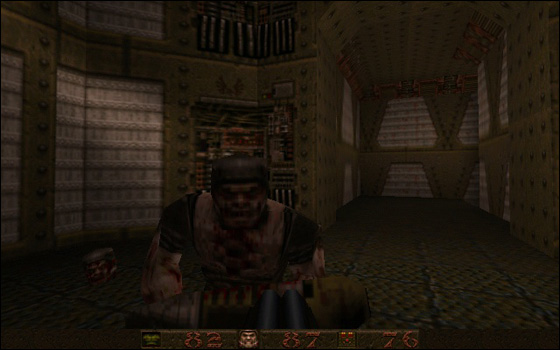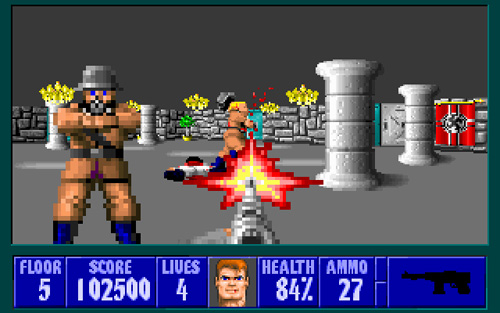Quake and the Feeling of Nightmare
December 19th, 2008

You may remember that I stashed a pile of classic PC games on my ailing laptop before making the trip over to Shanghai. It’s kind of strange then that I haven’t actually talked about any of those games up to now – with the obvious admission of a few, select indie titles. Finally I finished one of those classic PC games, being the original Quake, and here is my experience of life in hell.
Well actually, unlike its forefather; Doom, Quake isn’t really set in hell, it’s more of a sometimes-rustic-medieval-grudge/sometimes-rustic-futuristic-grunge like set up, with enemy types suitable for either décor. Despite not being set in Satan’s domain, Quake most certainly does a good job at making you feel in a sort of nightmare state;
Paralysis
Much like the build-and-expand-upon nature of id software’s first person shooter development, Quake plays much like a semi-evolution of Doom, in the same way that Doom expanded upon Wolfenstien 3D before it.
Quake’s most significant advancement over Doom is that it’s set in an actual three dimensional playing space and not in sprite scaling, pseudo 3D world. While the game is 3D in presentation, the ability to look on the vertical axis (up and down) with the mouse is absent from the game entirely, falsifying a true sense of 3D perspective. So basically, you have the enclosed feeling of Doom, in an open, 3D space. Unlike its sequel Quake II, vertically looking up and down is awkwardly mapped to the key pad, rather than being handled by the mouse (gliding forward and back). Having to look up or down then requires you to forfeit your hand at the mouse, forcing you to use one axis at a time. Furthermore, with auto-assist aiming used for targeting enemies on higher or lower planes, the need to look above or below is completely mute.
The lack of seemliness vertical sight places an unbalanced emphasis on the horizontal axis, as well as destroying the illusion that Quake is a 3D shooting game through both graphics and play mechanics. The latter breaks the visual intuition created by the 3D game world and makes Quake feel two steps digital, one step analog; a semi-evolution of Doom, instead of a “true” 3D offering. It works against the player’s expectations; intrusive and awkward, almost spiting the player for it.

The former (horizontal emphasis) elongates part of the movement set and ultimately becomes the crutch as to how you play the game; consistently crunching on the one axis. Yet the reliance on this axis is unnatural. People do not turn their heads on one plane, they freely move their head around with digression and so forth. The fast paced run also feels unnaturally skippy. Again, creating a separation between the game world and player, likening itself to something more foreign.
id Software: Qualities and Evolution (1991-1996)
December 17th, 2008

So I finally finished a real game (Quake, PC) while over here in China and not that free-to-download, labour-of-love indie stuff clamoring for my attention. I really enjoyed Quake and started throwing all of my thoughts together on the game when I realized that I don’t want to talk about Quake just yet. I’d really like to first preface my ideas by analyzing a chunk of id software’s chronology, a part that exemplifies a greater strength of the game and company as a whole.
The part that I wish to segment is Catacomb 3D (1991) through to Quake (1996).
Assets
When I think of id Software, two adhering qualities often come to mind. The first is obviously a technical efficiency to create high quality video game technology -engines and tools- which break through the latest industry thresholds. John Carmack; id’s programmer-extraordinaire and mascot of sorts is a glowing example of a strongly rooted focus on tech within the company. Each of the company’s key titles garners much enthusiasm by players, not just because of their subject matter, but because of the new ground it covers for the next series of high end games to follow, as well as imitate.
The second quality is technically well grounded game design. id’s games feel deeply rooted in the id mindset, which includes a somewhat calculated, mathematically apt approach to game design. Like a well balanced equation, id’s games feel finely measured, with every piece justified. The mechanics all lock into place with tightness, the variation, balancing and types of enemies all play to strengths and weaknesses fixed by the weapon selection. The labrynth styled levels almost play out to a well designed algorithm with increasing complexity. This initial emphasis on mathematical design, has grown into something of a trademark style for the company.
Segmented Games
Now let’s observe the relationship between these two entities over the course of this time period. Some of this is based off memory, so bear with me.
If we are to credit these qualities of the company to the various games in this time period, then it would be safe to say that Wolfenstein 3D should be remembered for most notably for its technical qualities than its overall gameplay. Much of the the groundwork for future first person shooting games was set by Wolfenstein and it’s early predecessor Catacomb 3-D.

What I find interesting about this seed in the evolution is that, fundamentally, the technology behind the game is what fuels the enjoyment by the player. Wolfenstein didn’t just reel in new technology for technology’s sake, the technology created opportunity for id to develop new forms of gameplay. Without the elements which define Wolfenstein as a game (the shooting and puzzle elements), the technology itself would be rendered useless. As such, both of these qualities cannot exist without the other.
With much respect though, Wolfenstein in the modern era feels more akin to a first-person Pacman, set in the same oblique, blue-walled, prison. Wolfenstein was a fine game, no doubt, but it lacked the interesting context, variation and playability of games like Doom and Quake. To be fair, this is solely my personal opinion. The claim that Wolfenstein is on equal, progressive footing with the other titles is a very reasonable claim. Still, it lacks a certain ageless-ness that is widely apparent in the other titles. Some of this can be chalked up to a technical level, in that, while the technology was new for the time, it only allowed for a strict amount of variables at any given time, limiting the games flexibility and keeping the gameplay a whitish vanilla.
Doom and Doom II evolved the Wolfenstein formula to the next level, creating a cultural identity for itself and video games as a whole. There are two reasons for Doom’s success and notably, its increased success over Wolfenstein. With Doom, id’s second quality began to step it up, of course, not possible without the technical side.
The first reason is context, unlike Wolfenstien, Doom was wrapped in one hell of a context. Setting itself in a violent, demonic world filled with various goulish creatures, Doom created a brand for itself out of violence. For many (particularly non-players of the game) the environment was the single most important feature of the game. For most people though, it was an eerily well designed setting which added a spark to the game.

The second reason is due to technology and its implementation with the gameplay. Rooms now had varying height, airing out the core level design. Light and texture draw your attention to set pieces in the level, unifying level and aesthetic design. The aural package weaves throughout this too, with stereo sound indicating an approximate location of enemies, making for some clever enemy placements which alert you of their growls but hinder you of their location. All of these things make Doom a much more progressive an evolved game. The fact that Doom essentially expands from Wolfenstein’s base, seems to indicate that id had much more time to grow their gameplay directive. Much of this can be seen in several of the levels which exemplify gameplay experimentation (the level in which you are entrenched by red barrels is a key example). So with Doom we see the technical and gameplay curve continue to increase.
Quake and Quake II (I’ve just started Quake II), show a continual evolution and formation into a a first person experience similar to the games of today. The fake two dimensional skin is lost in favour of 3D. I think that I will pen it here for today and discuss the Quake trilogy later on as a separate part of this series.
Fun for Five Minutes: Crash Commando
December 12th, 2008
Obviously life over here in Shanghai is consuming my time by the bowl fulls. I do have the intention of keeping this place as regularly updated as possible, but given the circumstances I’m not sure how much more toothpaste I can squeeze out the tube. In anycase, I have a terrible cold at the moment which has opened up the opportunity for a few days downtime admits the Christmas rush. As such I want to jump back into things with an almost PR-worthy piece plugging this awesome trailer that I just watched. Losing my credibility? Nah, not yet.
Okay, so that trailer I just saw was for Crash Commando for the Playstation Network. You might recall hearing about it last E3, it’s very much like a high definition Contra, with characters the size of ants and microscopic laser sights. It looks like a neat, inspired offering with a few new generation assets included
The trailer – while cliché in parts – is admittedly pretty cute. It takes the ethos surrounding its inspiration and churns out something pretty entertaining and humourous. Usually these intentionally over-the-top rips at flamboyant humour grow quite tiring, but this one made me giggle. I think it’s because the writing is probably better than most and not so jerky.
I honestly don’t believe that Crash Commando will be a particularly brilliant title, but hey that’s my engrossing for five minutes. I’ll try to get myself to write something more wholesome over the weekend. Likely something related to Quake, which I finished a few weeks ago.



 Game Design Companion: A Critical Analysis of Wario Land 4 - $7.99
Game Design Companion: A Critical Analysis of Wario Land 4 - $7.99 Level Design: Processes and Experiences
Level Design: Processes and Experiences Speed Boost: The Hidden Secrets Behind Arcade Racing Design - $5.99
Speed Boost: The Hidden Secrets Behind Arcade Racing Design - $5.99 Adventures in Games Analysis: Volume I - $5.99
Adventures in Games Analysis: Volume I - $5.99







